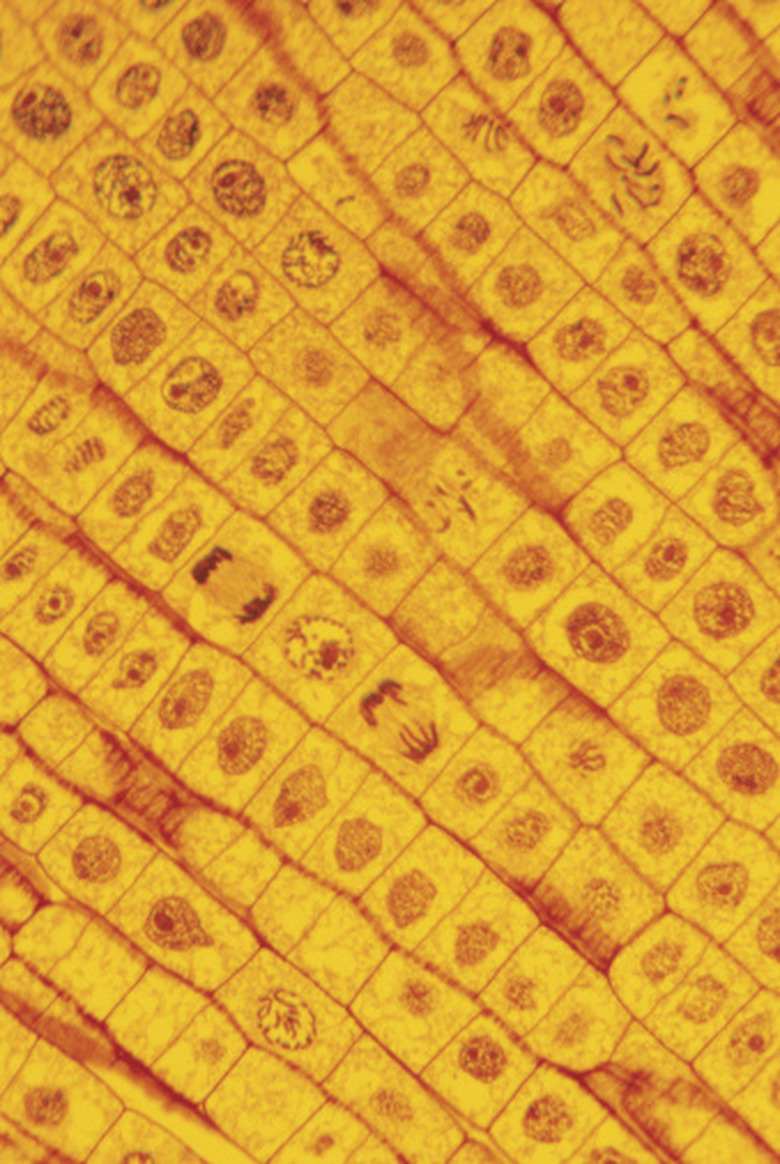How Does Mitosis Differ In The Cells Of Animals & Higher Plants?
From microscopic dinoflagellates to massive dinosaurs, life on Earth started with one cell containing a blueprint of instructions for growth and differentiation. Plants and animals are largely sustained through mitotic cell division and tissue replenishment. However, the mechanisms of mitosis are very different.
Plant and Animal Cell Morphology
Plant and Animal Cell Morphology
Plants are autotrophs containing chloroplasts and chlorophyll for photosynthesis. The abundant presence of chlorophyll gives plants a green color. Plant cells also have large vacuoles for storage of water and fortification of the cell wall. Cellulose walls hold plants up as they grow toward the sun.
Animals have bones to protect their organs and soft tissues. Plants only have a nimble cytoskeleton in their cytoplasm. Because plants cannot move on their own to escape, some plants have thorns in their outer cell wall to discourage grazing herbivores.
Plant and Animal Cell Similarities
Plant and Animal Cell Similarities
Plant and animal cells share some key similarities, most notably a nucleus within a nuclear membrane making them eukaryotic organisms. The genetic material of the cell is contained within the nucleus, replicated and parceled out during cell division. Plant and animal cells depend on mitochondria in the cytoplasm to create energy molecules.
Mitosis in Plants
Mitosis in Plants
Under favorable conditions, a plant cell can divide asexually by mitosis into two identical cells. The upside of mitosis is rapid growth. The downside of mitosis is limited biodiversity, which can be detrimental to survival if conditions change. Higher order plants can also reproduce sexually through meiosis.
The life cycle starts when diploid sporophytes divide by meiosis giving rise to haploid spores with half the number of chromosomes. Through mitosis, spores develop into multicellular gametophytes, which then produce haploid gametes. Fertilization happens when two haploid gametes come together forming diploid zygote that divides by mitosis to form a sporophyte.
Mitosis of an Animal Cell
Mitosis of an Animal Cell
Animal cells, like human cells, use mitosis to grow larger cells, replace damaged cells and repair injured tissue. Mitosis of an animal cell is an asexual reproductive process that produces two exact copies of a cell. Cellular growth and protein synthesis occur in interphase of the cell cycle.
During the mitotic phases, sister chromatids line up in the middle of the cell. Then, they're pulled apart by organelles and sent to opposite poles where the nuclear envelope reforms around the genetic material. Lastly, the animal cell membrane is pinched down the center to separate the two cells.
Mitosis in Plants vs. Animals
Mitosis in Plants vs. Animals
The nucleus drives mitosis by telling a cell to divide. The process and purpose of mitosis differs in plant and animal cells. For instance, mitosis takes into consideration that plants need a sturdy, cellulose cell wall because higher order plants lack the bony skeleton of an animal.
**Examples:**
- Differences in mitotic phases: Unlike animals, higher order plants undergo a cell cycle called preprophase. In preprophase, cytoplasm forms a line where a cell plate will form after completing mitosis.
- Organelle differences in plants: Plant cells contain chloroplasts necessary for autotrophs to perform photosynthesis. Plants have a larger vacuole to hold water and other fluids that regulate osmosis. During mitosis in plants, they can form spindle fibers and divide without centrioles.
- Organelle differences in animals: Animal cells have centrioles that assist with formation of the spindle apparatus and chromatid division. "It has been suggested that centrioles evolved as a refinement of the [animal] cell, making mitosis a much more efficient and less error-prone process," as reported by Florida State University cell biologists.
- **Differences in cytokinesis:** Higher order plant cells form a cell plate to separate the nuclei and cytoplasm of two identical cells after mitosis. In animal cells, motor proteins (actin and myosin) constrict the cell membrane at a spot called the cleavage furrow. Membrane fusion splits the cells into two separate entities.
In What Type of Cells Does Mitosis Occur?
In What Type of Cells Does Mitosis Occur?
Most of the cell division taking place in living organisms happens in somatic (non-reproductive) cells through mitosis. For instance, the human body sheds and replaces up to 40,000 skin cells per day, according to the American Academy of Dermatology. Plant cells grow in size and number through mitosis and continual repetitions of the cell cycle.
Cite This Article
MLA
Dowd, Mary. "How Does Mitosis Differ In The Cells Of Animals & Higher Plants?" sciencing.com, https://www.sciencing.com/mitosis-cells-animals-higher-plants-8050979/. 30 July 2019.
APA
Dowd, Mary. (2019, July 30). How Does Mitosis Differ In The Cells Of Animals & Higher Plants?. sciencing.com. Retrieved from https://www.sciencing.com/mitosis-cells-animals-higher-plants-8050979/
Chicago
Dowd, Mary. How Does Mitosis Differ In The Cells Of Animals & Higher Plants? last modified August 30, 2022. https://www.sciencing.com/mitosis-cells-animals-higher-plants-8050979/
